Chromosome catastrophes involve replication mechanisms generating complex genomic rearrangements
- PMID: 21925314
- PMCID: PMC3242451
- DOI: 10.1016/j.cell.2011.07.042
Chromosome catastrophes involve replication mechanisms generating complex genomic rearrangements
Abstract
Complex genomic rearrangements (CGRs) consisting of two or more breakpoint junctions have been observed in genomic disorders. Recently, a chromosome catastrophe phenomenon termed chromothripsis, in which numerous genomic rearrangements are apparently acquired in one single catastrophic event, was described in multiple cancers. Here, we show that constitutionally acquired CGRs share similarities with cancer chromothripsis. In the 17 CGR cases investigated, we observed localization and multiple copy number changes including deletions, duplications, and/or triplications, as well as extensive translocations and inversions. Genomic rearrangements involved varied in size and complexities; in one case, array comparative genomic hybridization revealed 18 copy number changes. Breakpoint sequencing identified characteristic features, including small templated insertions at breakpoints and microhomology at breakpoint junctions, which have been attributed to replicative processes. The resemblance between CGR and chromothripsis suggests similar mechanistic underpinnings. Such chromosome catastrophic events appear to reflect basic DNA metabolism operative throughout an organism's life cycle.
Copyright © 2011 Elsevier Inc. All rights reserved.
Figures
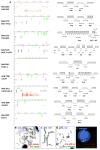
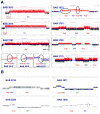
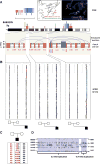
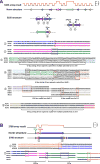
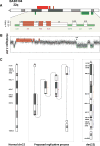

References
-
- Bailey JA, Gu Z, Clark RA, Reinert K, Samonte RV, Schwartz S, Adams MD, Myers EW, Li PW, Eichler EE. Recent segmental duplications in the human genome. Science. 2002;297:1003–1007. - PubMed
-
- Batista DA, Pai GS, Stetten G. Molecular analysis of a complex chromosomal rearrangement and a review of familial cases. Am J Med Genet. 1994;53:255–263. - PubMed
-
- Borg K, Stankiewicz P, Bocian E, Kruczek A, Obersztyn E, Lupski JR, Mazurczak T. Molecular analysis of a constitutional complex genome rearrangement with 11 breakpoints involving chromosomes 3, 11, 12, and 21 and a approximately 0.5-Mb submicroscopic deletion in a patient with mild mental retardation. Hum Genet. 2005;118:267–275. - PubMed
Publication types
MeSH terms
Grants and funding
LinkOut - more resources
Full Text Sources
Other Literature Sources
Medical
Molecular Biology Databases

